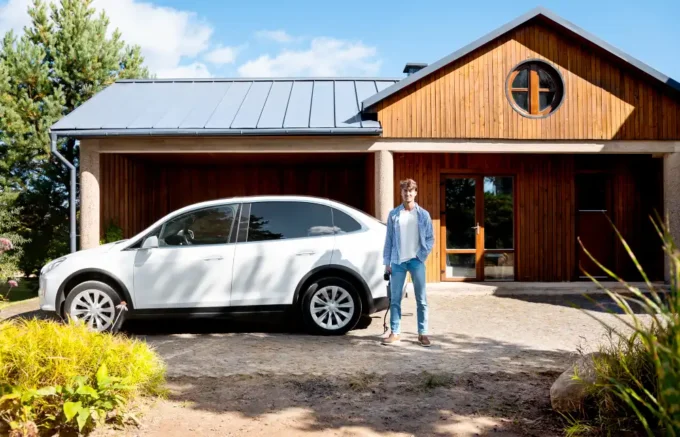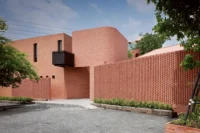In the ever-evolving world of architecture, parametric design has emerged as a game-changer, revolutionizing how we conceptualize and create spaces. By leveraging algorithms and computational techniques, architects can now explore a vast array of design possibilities that were previously unimaginable. This innovative approach not only enhances creativity but also optimizes functionality and sustainability.
Parametric architecture allows us to manipulate design parameters dynamically, resulting in structures that are both aesthetically pleasing and highly efficient. Studies have shown that this method can significantly improve daylighting and energy efficiency, making it an essential tool in sustainable building practices. As we delve into the intricacies of parametric design, we’ll uncover how this cutting-edge technology is shaping the future of architecture and urban planning.
Understanding Parametric Architecture
What Is Parametric Architecture?
Parametric architecture leverages algorithms and mathematical equations to create adaptable designs. This approach allows architects to define design parameters within CAD software, making it possible to automatically adjust the entire design when one parameter changes. By using this dynamic model, architects achieve intricate and complex structures that are both aesthetically pleasing and functionally efficient. Parametric design addresses challenges like environmental sustainability, urban planning, and social dynamics, enabling innovative solutions in these areas.

Historical Evolution of Parametric Design
The concept of parametric design has roots dating back to Antonio Gaudi’s work in the early 20th century. He used an analog method involving suspended weighted strings to create intricate catenary arches, demonstrating early principles of parametric modeling. The term “parametric architecture” was first coined by Luigi Moretti in the mid-20th century. Frei Otto expanded the field by experimenting with form-finding techniques derived from natural phenomena like soap films and paths. Over the past 20 years, advancements in computational tools and methods have propelled parametric design to new heights, making it a cornerstone of modern architectural practice.
By understanding its history and functionality, we can better appreciate the transformative potential of parametric architecture in the built environment.
Core Principles of Parametric Architecture
The Role of Mathematics in Parametric Design
Mathematics serves as the foundation of parametric design. By employing algorithms and mathematical equations, architects define variable parameters that influence the final structure. These algorithms allow for the creation of adaptive models that can change shape in response to varying inputs. For example, adjusting the curvature of a facade or the spacing between structural elements becomes seamless through mathematical manipulation. This precision ensures optimal performance and efficiency, making structures both functional and aesthetically pleasing.
From Concept to Reality: How Parametric Design Transforms Ideas
Parametric design transforms abstract ideas into tangible structures by rapidly iterating through design variations. Initially, architects generate a digital 3D model using parametric software, refining the form through multiple iterations. This approach enables the exploration of numerous design options quickly. The process moves from the conceptual stage to detailed design, where structural performance and efficiency are optimized. For instance, in the case of the Tokyo Skytree, parametric design helped achieve a slender tapering form that maximizes spatial use while minimizing wind resistance. This methodology bridges the gap between visionary concepts and their physical realization, ensuring that the final structure meets specific site and program requirements.
Applications of Parametric Design in Architecture
Notable Global Examples of Parametric Buildings
Parametric design has produced several iconic structures worldwide. Frank Gehry’s “Peix Olímpic” in Barcelona showcases how organic shapes can inspire modern buildings. Gehry often uses nature’s forms to create functional yet artistic structures, exemplified in this fish-shaped sculpture, which blends seamlessly into the urban landscape.
Tokyo Skytree stands as another testament to parametric design. At 634 meters, this tower utilizes parametric techniques to minimize wind resistance while maximizing space. The result is a slender, tapering form that accommodates broadcasting and observation functions, illustrating the capability of parametric design in solving architectural challenges.
Antonio Gaudí’s upside-down models for the Church of Colònia Güell provide historical examples of parametric principles. Gaudí used weighted strings to visualize how gravity would affect vaulted ceilings. This analog approach effectively modeled how forces interact within a structure, a concept now refined through computational parametric design.
Frei Otto’s tensegrity structures for the 1972 Summer Olympics in Munich highlight another application. Otto’s use of non-digital parametric models to create lightweight, stable forms continues to influence modern architectural designs that seek efficiency and aesthetic harmony.

Impact on Urban and Industrial Design
Parametric design reshapes urban and industrial landscapes by enabling complex, adaptable structures. These designs address sustainability by optimizing material usage and improving energy efficiency. Architects use parametric principles to evaluate how buildings interact with their environment, thus reducing negative impacts.
In urban planning, parametric architecture offers flexible solutions for densely populated areas. Designers can swiftly model various scenarios, considering factors like pedestrian flow, sunlight access, and wind patterns. This iterative process ensures urban environments that are both functional and aesthetically pleasing.
Industrial design benefits from parametric techniques through improved product efficiency and reduced waste. By tweaking design parameters, industries can quickly adapt to new requirements or optimize existing products. This adaptability extends across sectors, from automotive to consumer electronics, highlighting the broad utility of parametric design principles.
Incorporating parametric methods in both urban and industrial contexts aligns with our commitment to sustainability and innovation. Advanced computational tools further enhance these designs, enabling seamless integration of complex variables into cohesive and optimal structures.
Tools and Software for Parametric Architecture
Essential Software for Parametric Modeling
Parametric architecture relies heavily on advanced software to create and manipulate complex designs. Key software tools include Rhino 3D and Grasshopper. Rhino 3D is renowned for its ability to handle intricate geometry and serves as a robust platform for architects. Grasshopper, a visual programming language for Rhino, enables designers to build parametric models through algorithmic processes. Together, these tools provide a powerful combination for developing innovative architectural solutions.
Grasshopper excels in parametric modeling by allowing users to define relationships between geometrical components. This capability ensures that any change in design parameters instantly reflects across the model, streamlining the design process. Architects and urban designers use Grasshopper not just for building geometries but also for urban planning scenarios, enhancing both efficiency and creativity.
Tools like Cinema 4D, paired with plug-ins like Corona Renderer, offer additional capabilities for rendering and visualization. Such tools are essential for converting parametric models into photorealistic images, aiding in presentations and client communications. They bridge the gap between technical modeling and aesthetic presentation, providing a complete suite for modern architectural practices.
Specialized workshops and courses on these software tools further empower architects and urban planners with the skills required for parametric design. By mastering these applications, designers can explore a wider range of possibilities and optimize their designs for functionality and visual appeal.

The Future of Parametric Architecture
Innovations and Trends in Parametric Design
The future of parametric architecture is brimming with innovations and trends that are pushing the boundaries of design. Emerging technologies such as artificial intelligence (AI) and machine learning (ML) are revolutionizing how we approach architectural challenges. AI algorithms can analyze vast datasets to predict optimal design solutions, enhancing the efficiency and precision of parametric models.
3D printing technology is also making significant strides. Architects can now produce complex, customized structures with incredible accuracy and speed. This advancement not only reduces material waste but also allows for the creation of geometries that were previously impossible using traditional construction methods.
Augmented Reality (AR) and Virtual Reality (VR) are enhancing design visualization. These tools enable architects to immerse themselves in their creations, allowing for real-time adjustments and more intuitive design processes. Through these innovations, parametric architecture is becoming more interactive and user-friendly, bridging the gap between concept and reality.
Environmental and Sustainability Considerations
Environmental sustainability is at the forefront of parametric architecture. The ability to optimize structures for energy efficiency and minimal environmental impact is a significant advantage of parametric design. By integrating environmental data into the design parameters, architects can create buildings that respond dynamically to their surroundings.
One prominent trend is the use of parametric tools to optimize daylighting. By precisely calculating angles, orientations, and materials, architects can maximize natural light, reducing the need for artificial lighting and, consequently, lowering energy consumption. Studies, such as the one published in the Renewable and Sustainable Energy Reviews (2017), highlight the effectiveness of parametric design in enhancing daylighting.
Sustainable materials are also being explored through parametric models. The parametric approach allows for precise material calculations, reducing waste and promoting the use of eco-friendly resources. By testing various materials and configurations digitally, we can achieve efficient and sustainable outcomes before actual construction begins.
In urban planning, parametric design facilitates the creation of green spaces and the optimization of urban landscapes for environmental harmony. This approach enables architects and planners to create sustainable communities that balance built and natural environments, fostering healthier and more aesthetic urban living.
The future of parametric architecture lies in leveraging these innovations and sustainability practices to create structures that are not only visually stunning but also environmentally responsible. Through continuous technological advancements, parametric design is set to transform the architectural landscape, offering new possibilities for creativity and efficiency.

Conclusion
Parametric architecture stands as a transformative force in the contemporary architectural landscape. By leveraging algorithmic and computational tools, we’ve seen significant advancements in design flexibility, efficiency, and sustainability. Historical figures like Antonio Gaudí and Luigi Moretti laid the groundwork, which evolved into today’s sophisticated computational approaches.
The principles of parametric architecture revolve around mathematics to define variable parameters. This results in optimized performance and designs tailored to specific needs. Examples like Frank Gehry’s “Peix Olímpic” illustrate practical applications, highlighting the balance between aesthetics and functionality.
Key tools such as Rhino 3D and Grasshopper enable the creation of intricate designs through algorithmic processes. Cinema 4D and Corona Renderer enhance rendering, bringing these complex structures to life with stunning visuals. The continuous improvement in these tools ensures that parametric architecture remains at the forefront of innovative design.
Looking forward, artificial intelligence (AI) and machine learning (ML) are poised to revolutionize design methodologies. These technologies facilitate the creation of more adaptive and intelligent structures. Our ability to 3D print complex, customized designs with precision not only accelerates the construction process but also reduces material waste.
Augmented Reality (AR) and Virtual Reality (VR) enter the scene, offering immersive visualization experiences, making architecture more interactive. Sustainability remains a critical focus, with parametric design optimizing structures for energy efficiency and minimal environmental impact. Techniques for daylighting optimization and the use of sustainable materials further enhance our environmental responsibility.
Parametric design also plays a pivotal role in urban planning, aiding in the creation of sustainable communities. By integrating these innovative practices, we can expect the future of parametric architecture to yield visually stunning, efficient, and environmentally conscious structures. The horizon of parametric architecture holds endless possibilities, transforming how we conceptualize and execute architectural projects.
- 3D architecture design
- advanced building design
- algorithmic design
- Architectural Design
- Architectural Technology
- architecture automation
- architecture innovation
- Architecture Trends
- computational architecture
- design technology in architecture
- digital architecture
- future of design
- generative design architecture
- modern architectural design
- next-gen architecture
- parametric architecture
- parametric design in architecture
- parametric modeling
- smart architecture solutions
- Sustainable Architecture
















Leave a comment